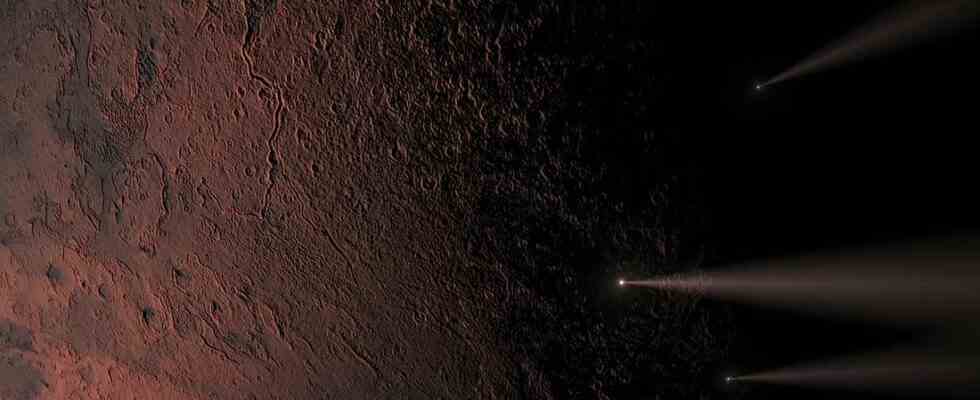On Mars, a research team makes a surprising discovery: the planet is apparently still active beneath the surface.
Tucson – On Earth, shifting tectonic plates are causing the planet’s surface to change, while the interior is dynamic. Because it’s on the Mars There is no plate tectonics, Mars was long considered a “dead” planet. But the NASA-Space probe “InSight” has in recent years numerous marsquakes recorded and apparently there’s a lot going on beneath the red planet’s surface, a new study shows.
For the study that in the journal Nature Astronomy released researchers from the University of Arizona have re-analyzed all available data on Mars’ Elysium region. “Our study presents several lines of evidence supporting the presence of a giant active mantle plume on modern-day Mars,” said Adrien Broquet, co-author of the study, in a statement.
Researchers find mantle plume on Mars – explanation for marsquakes
Mantle plumes are large bubbles of warm and buoyant rock that rise from a planet’s interior and push through its mantle to its crust. The result can be earthquakes, faults and volcanic eruptions. For example, on Earth, the island chain of Hawaii was formed as the Pacific Plate slowly drifted over a mantle plume.
“We have strong evidence that mantle plumes are active on Earth and Venus, but this is not expected on a small and supposedly cold world like Mars,” said co-author Jeff Andrews-Hanna. “Mars was at its most active three to four billion years ago and the prevailing view is that the planet is essentially dead today.”
Mars wasn’t always a “dead” planet
This was not always the case: Mars has the largest volcanoes in the solar system, and much of the red planet’s northern hemisphere is covered with volcanic deposits. “The low activity in recent history is usually attributed to passive processes on a cooling planet,” says Broquet.
But the Elysium region is different: there have been major eruptions over the past 200 million years. “Previous work by our group has found evidence of the most recent known volcanic eruption on Mars in the Elysium region,” says Andrews-Hanna. “It caused a small explosion of volcanic ash about 53,000 years ago, which in geological time is practically yesterday.”
Mars has no plate tectonics – but mantle plumes give themselves away
Because the researchers know that Mars has no plate tectonics, the team investigated whether the observed activity could be the result of a mantle plume. Mantle plumes reveal themselves through a specific sequence of events: Warm material rises and strikes the surface, pushing up and stretching the crust. The molten rock from the mantle plume then erupts as flood basalt, forming vast volcanic plains.
Volcanism in the Martian region of Elysium originates in the Cerberus Fossae, a series of young fissures that stretch more than 1,300 kilometers across the Martian surface. The “InSight” team found that almost all measured marsquakes emanate from this region – but the cause for this remained unknown.
Space Newsletter
Subscribe to the free space newsletterto get the latest news twice a month astronomy and space travel to get it in your mailbox.
Now the researchers have found evidence of the exact sequence of events that reveals a mantle plume: the surface was raised, creating one of the highest regions in the northern lowlands of Mars. Further exploration showed that other evidence also pointed to a mantle plume. When the researchers applied a tectonic model to the region, they found that a gigantic mantle plume some 4,000 kilometers wide was the only explanation for the formation of the Cerberus fossae.
New discovery on Mars could also have implications for search for life
“This mantle plume affects an area of Mars roughly the size of the United States. Future studies will have to find a way to explain this,” says Broquet. Experts would have thought that “InSight” landed in one of “the most geologically boring regions on Mars,” Broquet continues. “Instead, our study shows that ‘InSight’ landed on the head of an active mantle plume.”
| celestial body: | planet |
| Surname: | Mars |
| moons: | 2 (Phobos and Deimos) |
| Temperature: | minimum -153 °C, average -63 °C, maximum +20 °C |
Broquet is certain that the new discovery is a paradigm shift. Because it could also have an impact on the search for life on Mars. Heat from the mantle plume could also melt ice, creating liquid water, which in turn could fuel chemical reactions that could support life deep underground. “Microbes on Earth thrive in such environments, and this could be the case on Mars,” Andrews-Hanna points out.
And the new study has raised new questions in another way, too: “Knowing that there is an active giant mantle plume beneath the surface of Mars raises important questions about how the planet evolved over time,” explains Andrews- Hanna. “We are convinced that the future holds more surprises.” (tab)

